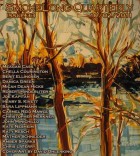I am a sucker for stories where the voice is unique and especially when the character is someone whose experiences are so different from my own. This is exactly what “The Language of Hairzilla” gives me. Can you talk a little about this character and where you “found” him?
This spring, I was writing about my nappy hair as a way of showing my relationship with my biracial identity. “The Language of Hairzilla” is a condensed version of the middle of that writing, where I was describing being involved in the punk scene after my family moved to Richmond, Virginia. The last bit is about what happened when I moved to New York City and grew dreadlocks. nthWORD Shorts ran that segment as “The Impersonator.” The beginning section of that longer piece is about my white mother being the barber for everyone in our family. Still working on that.
You use second person, which adds much to the urgency and energy of the character. What prompted you to choose second person and how easy was it for you to do so?
I’ve been skeptical of second person because it can feel gimmicky. I decided to try it because I had 3,000 words that I knew were dragging. In a lot of my pieces about being mixed, I feel weighed down by context and backstory. How can I tell the reader what they need to know about my race, appearance, financial issues and multiple hometowns without slowing the story? I hoped that the “you” would drop the reader right in, and force an understanding as things happen to “them,” leaving me with less to explain. Working on it, I was reminded of choose your own adventure stories, which are also written in second. They have a camp quality that I hoped would jive with the superhero origin aspects of “Hairzilla.”
The structure here is deceptive in the way it reveals backstory. First you present the character vividly and in action, then you give us a list of infractions. At this point we’re led to think that, with all his charm, he’s headed for real trouble, but then you surprise us with typical-kid violations of adult rules. And then the why which shifts our perspective about what’s really going on. How did you arrive at this structure? At what point in your process do you take a hard look at structure?
With the infractions, I wanted to give an outside perspective on the character. Yes, he’s having a tough time, but he’s also a snotty teenager. I hoped to make his rebellion less one-sided by pointing a few middle fingers back at him.
Structure-wise, I was trying to write about my entire nine years in the Richmond punk scene. As I was going over an early draft, it became clear that most of the problems that caused me to pull back from punk were present from the beginning, so that arc could be shared in less time.
In real life, I did a lot in that world. My old band Light the Fuse and Run released a couple records and toured the U.S., Canada and Europe. Those tours are actually where I met Myles Karr, who did the art for this piece. I’ve been watching him evolve as an illustrator and tattoo artist for ten years now. I love his stuff.
I see from your bio that you are biracial and were part of a punk band, which accounts for some of the story’s authenticity. One of the strengths of this piece can be found in the boy’s “outsider” status wherever he goes. This adds universality to the theme of “Hairzilla.” Do you think most people feel like outsiders?
Yes, this story is drawn very closely from my life, but I maintain that I never turned into a punk rock lizard!
When I write about being biracial, I worry that I’m playing into tragic mulatto stereotypes, of the miserable mixed-race person who never feels at home. I think that rootless, confused feeling is amplified by writing about punk, which is generally a place for misfits. So, if punk is so popular, then a lot of people feel like outsiders. I still feel most comfortable among people who are somehow atypical: ghetto nerds, gender-bending queers, afro punks…anyone who’s different enough to be forced to constantly consider what makes them tick, and why it does. I have zero interest in people who aren’t always questioning the world around them.
You’ve been working on your MFA. Where would you like to see yourself as a writer in say five years?
I’d love to see my young adult novel published. It has themes of homophobia and bullying and I’m beginning to shop it to agents. A couple excerpts have been published, like this one in Trilling Magazine.
Also, I’ve got over 100 pages of material about being half black/half white. I return to these shorter pieces when I get tired of having to consider the novel’s sustained narrative. I dream of having them published in a collection with a name like Wigger Jams. I’m among the first generation of people born to legally married, interracial parents, and I think our experiences need to be recorded and shared.
And lastly, who do you read? What books do you love? And why?
James Baldwin is my easy, go-to answer for favorite author questions.
I really like anything that gives a skewed version of hip-hop and race. Junot Diaz’s urban nerd stories. Black characters pondering middle class conservatism while getting told that they “talk white” by their ghetto brethren. Paul Beatty’s White Boy Shuffle is a good example of that. Ann Petry’s The Narrows is similar, but a few generations back. Adam Mansbach does something really important by pondering the white/assimilated Jewish role in the back and forth between white culture and black arts, and he has an obvious love for words.
I’m rereading passing narratives by Nella Larson and James Weldon Johnson, and seeking more stuff along those lines as I write more about times when I’ve accidentally passed for white.
My favorite genre is hardboiled detective stories. I love the use of voice in Raymond Chandler, and I swear I hear every wiseass I ever knew in Boston when I read Dennis Lehane.
I’m currently flying through Audrey Niffenegger’s The Time Traveler’s Wife, and realizing that I have a soft spot for love stories.



 The SmokeLong Grand Micro Contest (The Mikey) is now an annual competition celebrating and compensating the best micro fiction and nonfiction online.
The SmokeLong Grand Micro Contest (The Mikey) is now an annual competition celebrating and compensating the best micro fiction and nonfiction online.